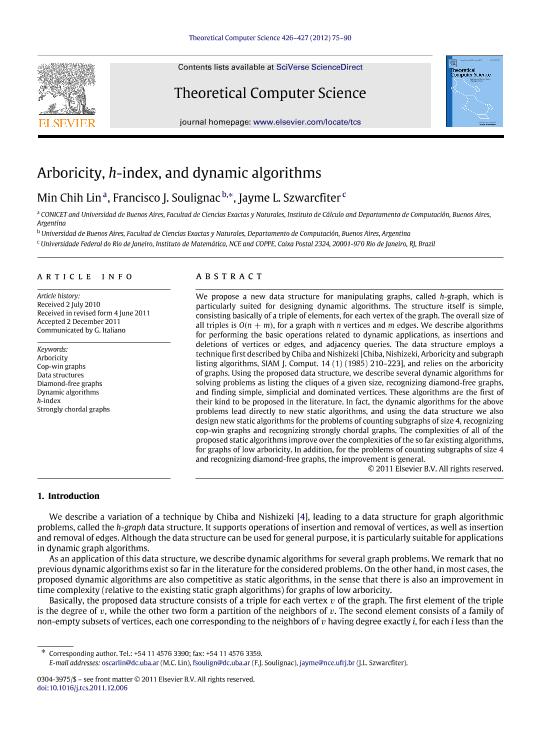Mostrar el registro sencillo del ítem
dc.contributor.author
Lin, Min Chih

dc.contributor.author
Soulignac, Francisco Juan

dc.contributor.author
Szwarcfiter, Jayme L.

dc.date.available
2020-09-08T20:57:05Z
dc.date.issued
2012-04
dc.identifier.citation
Lin, Min Chih; Soulignac, Francisco Juan; Szwarcfiter, Jayme L.; Arboricity, h-Index, and Dynamic Algorithms; Elsevier Science; Theoretical Computer Science; 426-427; 4-2012; 75-90
dc.identifier.issn
0304-3975
dc.identifier.uri
http://hdl.handle.net/11336/113567
dc.description.abstract
We propose a new data structure for manipulating graphs, called -graph, which is particularly suited for designing dynamic algorithms. The structure itself is simple, consisting basically of a triple of elements, for each vertex of the graph. The overall size of all triples is , for a graph with vertices and edges. We describe algorithms for performing the basic operations related to dynamic applications, as insertions and deletions of vertices or edges, and adjacency queries. The data structure employs a technique first described by Chiba and Nishizeki [Chiba, Nishizeki, Arboricity and subgraph listing algorithms, SIAM J. Comput. 14 (1) (1985) 210–223], and relies on the arboricity of graphs. Using the proposed data structure, we describe several dynamic algorithms for solving problems as listing the cliques of a given size, recognizing diamond-free graphs, and finding simple, simplicial and dominated vertices. These algorithms are the first of their kind to be proposed in the literature. In fact, the dynamic algorithms for the above problems lead directly to new static algorithms, and using the data structure we also design new static algorithms for the problems of counting subgraphs of size 4, recognizing cop-win graphs and recognizing strongly chordal graphs. The complexities of all of the proposed static algorithms improve over the complexities of the so far existing algorithms, for graphs of low arboricity. In addition, for the problems of counting subgraphs of size 4 and recognizing diamond-free graphs, the improvement is general. which is particularly suited for designing dynamic algorithms. The structure itself is simple, consisting basically of a triple of elements, for each vertex of the graph. The overall size of all triples is O(n+m), for a graph with n vertices and m edges. We describe algorithms for performing the basic operations related to dynamic applications, as insertions and deletions of vertices or edges, and adjacency queries. The data structure employs a technique first described by Chiba and Nishizeki [Chiba, Nishizeki, Arboricity and subgraph listing algorithms, SIAM J. Comput. 14 (1) (1985) 210–223], and relies on the arboricity of graphs. Using the proposed data structure, we describe several dynamic algorithms for solving problems as listing the cliques of a given size, recognizing diamond-free graphs, and finding simple, simplicial and dominated vertices. These algorithms are the first of their kind to be proposed in the literature. In fact, the dynamic algorithms for the above problems lead directly to new static algorithms, and using the data structure we also design new static algorithms for the problems of counting subgraphs of size 4, recognizing cop-win graphs and recognizing strongly chordal graphs. The complexities of all of the proposed static algorithms improve over the complexities of the so far existing algorithms, for graphs of low arboricity. In addition, for the problems of counting subgraphs of size 4 and recognizing diamond-free graphs, the improvement is general.
dc.format
application/pdf
dc.language.iso
eng
dc.publisher
Elsevier Science

dc.rights
info:eu-repo/semantics/openAccess
dc.rights.uri
https://creativecommons.org/licenses/by-nc-nd/2.5/ar/
dc.subject
ARBORICITY
dc.subject
COP-WIN GRAPHS
dc.subject
DATA STRUCTURES
dc.subject
DIAMOND-FREE GRAPHS
dc.subject
DYNAMIC ALGORITHMS
dc.subject
H-INDEX
dc.subject
STRONGLY CHORDAL GRAPHS
dc.subject.classification
Matemática Aplicada

dc.subject.classification
Matemáticas

dc.subject.classification
CIENCIAS NATURALES Y EXACTAS

dc.title
Arboricity, h-Index, and Dynamic Algorithms
dc.type
info:eu-repo/semantics/article
dc.type
info:ar-repo/semantics/artículo
dc.type
info:eu-repo/semantics/publishedVersion
dc.date.updated
2020-09-08T14:02:57Z
dc.journal.volume
426-427
dc.journal.pagination
75-90
dc.journal.pais
Países Bajos

dc.journal.ciudad
Amsterdam
dc.description.fil
Fil: Lin, Min Chih. Universidad de Buenos Aires. Facultad de Ciencias Exactas y Naturales. Departamento de Computación; Argentina. Universidad de Buenos Aires. Facultad de Ciencias Exactas y Naturales. Instituto de Cálculo; Argentina. Consejo Nacional de Investigaciones Científicas y Técnicas. Oficina de Coordinación Administrativa Ciudad Universitaria; Argentina
dc.description.fil
Fil: Soulignac, Francisco Juan. Universidad de Buenos Aires. Facultad de Ciencias Exactas y Naturales. Departamento de Computación; Argentina. Consejo Nacional de Investigaciones Científicas y Técnicas. Oficina de Coordinación Administrativa Ciudad Universitaria; Argentina
dc.description.fil
Fil: Szwarcfiter, Jayme L.. Universidade Federal do Rio de Janeiro; Brasil
dc.journal.title
Theoretical Computer Science

dc.relation.alternativeid
info:eu-repo/semantics/altIdentifier/doi/http://dx.doi.org/10.1016/j.tcs.2011.12.006
dc.relation.alternativeid
info:eu-repo/semantics/altIdentifier/url/https://www.sciencedirect.com/science/article/pii/S0304397511009662
dc.relation.alternativeid
info:eu-repo/semantics/altIdentifier/url/https://arxiv.org/abs/1005.2211
Archivos asociados
